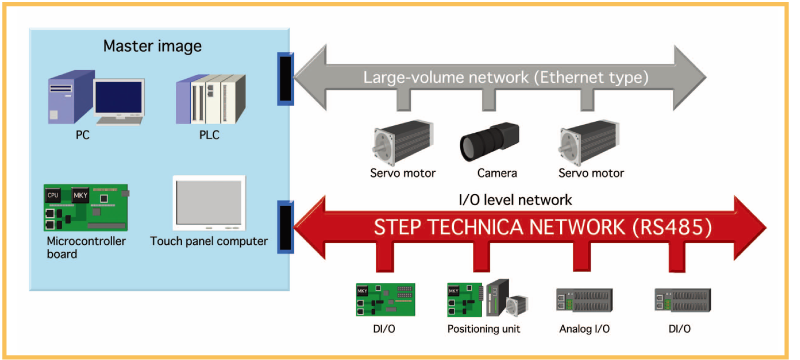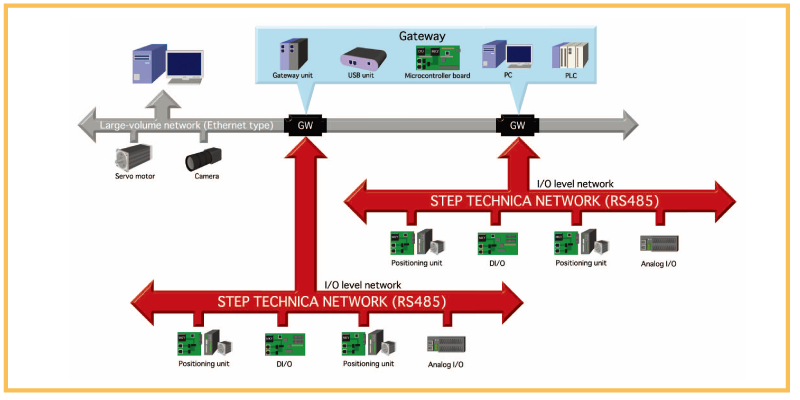Start
What are HLS and CUnet?
HLS and CUnet are I/O level networks that have excellent anti-noise performance and can successfully reduce wiring for factory automation equipment. They make it simple and fast to control digital I/O, analog I/O, and positioning. Also, they have no constraints from associations (groups, etc.), so you can purchase even only one unit. Thus, they provide an open network that can solve a variety of problems users’ experience.

HLS is a "one master and multiple slaves" network that can control digital I/O at Ultrahigh-speed, as a batch. It supports control as fast as 15 µs per node.

CUnet is a "multiple master and multiple slaves" network that controls digital I/O, analog I/O, and positioning. A variety of I/Os can be controlled with 1 chip. This control data is shared across the whole network in real-time.
Application examples
HLS and CUnet are used in a variety of fields, from semiconductor manufacturing equipment to medical equipment and bicycle parking control.
Applications of HLS and CUnet
HLS and CUnet are widely used for various systems in FA field.
- Chip mounters
- Semiconductor manufacturing equipment
- Injection molding machines
- Large printers
- Automatic carrier robots
- Welding machines
- Electrical discharge machines
- Pachinko hall control systems
- Security control systems
- Warehouse management system
- Medical equipment
- NC machine tools
- RFID systems
- Train traffic control system
- Building management system
- Amusement park control systems
- Traffic information control systems (road signal)
- Multi-axis motion controller
- Semiconductor manufacturing equipment
- Large printer
- Wafer carrier devices
- LCD panel devices
- Parking management systems
- Industrial robots
- Humanoid robots
- Building access control systems (entrance/exit)
- Golf driving range system
- Fireworks launch system
Should Ethernet be used for I/O control?
With the growth of industrial Ethernet, it is becoming increasingly common to consider Ethernet for I/O control. However, we do not necessarily recommend it, considering the cost of slaves, the time to set up the network, etc. We think that Ethernet-based networks are appropriate for images, servomotors, and large data. However, do you really need large packets to carry small bit data on the level of 8, 16, or 32 bits? The larger the packets are, the greater the risk of noise. Also, if slaves for an Ethernet-based network are distributed to save wiring, the per-unit cost gets higher.
Therefore, Step Technica believes that I/O control networks need appropriate cost, appropriate speed, appropriate noise resistance, and appropriate usability. Step Technica's networks are RS-485-based I/O level networks that can control digital I/O, analog I/O, and positioning. They allows analog control and positioning control to be performed on 1 chip, thereby greatly saving slave costs and helping to build a network appropriate for I/O control.
However, Step Technica's networks cannot control everything. Thus, we propose parallel network deployment in a 2-line configuration with an Ethernet-based network. Alternatively, we propose a 1-line configuration in which an Ethernet-based network is set up as the backbone network and I/O is controlled using a gateway.
Ethernet type mass network and an I/O network are used parallel.
Two-line configuration

Connecting a gateway to a large-volume Ethernet network
One-line configuration

The advantages of using HLS and CUnet on I/O level network
HLS and CUnet which can realize high-speed response easily
HLS and CUnet are highly valued by various customers using semiconductor manufacturing devices and machine tools that require high noise immunity, long distance, and high-speed response.
| Cost saving | Enabling configuration of the network with I/O devices of appropriate bit number |
| Few load on user CPU | HLS and CUnet communicate independently without user CPU (built-in protocol). |
| Stable communication | High tolerance for noise |
| Configuring an optimal network for the system required by customers |
Two-line connection with controller and gateway connection with large-volume network are available. |
| Extension of control target on I/O network | Even the devices conventionally controlled in upper level such as motor control can be controlled. |
User-friendly FA-dedicated
Control network iCs.
■Comparative table of HLS and CUnet
| HLS | CUnet | |
|---|---|---|
| Network structure | 1:N | N:N |
| Features | High-speed DIO control | Data sharing Intelligent DIO, analog IO, and positioning control |
| Control method | Read/Write memory | Read/Write memory |
| Communication method | Master/Slave type polling method | Multi-master type broadcast method |
| Connection topology | Multi-drop (RS485) | Multi-drop (RS485) |
| Communication speed | 12 Mbps/6 Mbps/3 Mbps (full duplex/half duplex) | 12 Mbps/6 Mbps/3 Mbps (half duplex) |
| Communication cable | Shielded cable of more than category 5 | Shielded cable of more than category 5 |
| Number of connection nodes | 63 | 64 |
| Minimum data length | DIN: 16 bits, DOUT: 16 bits | 8 bytes |
| Maximum data length | DIN: 1008 bits, DOUT: 1008 bits | 512 bytes |
| Fastest response (per terminal) | 15 μsec | Approx. 30 μsec |
| Fastest response (when all terminals are operating) | 955 μsec | 2365 μsec |
| Digital IO control | Suitable | Suitable |
| Analog control | Partially suitable | Suitable |
| Positioning control | Not suitable | Suitable |
| Communication distance (at 12 Mbps) | 100 m | 100 m |
| Communication distance (at 6 Mbps) | 200 m | 200 m |
| Communication distance (at 3 Mbps) | 300 m | 300 m |
| Topology | Bus (when using HUB: tree/star) | Bus (when using HUB: tree/star) |
Note: The trademark described in this document are the registered trademarks of the respective companies.
